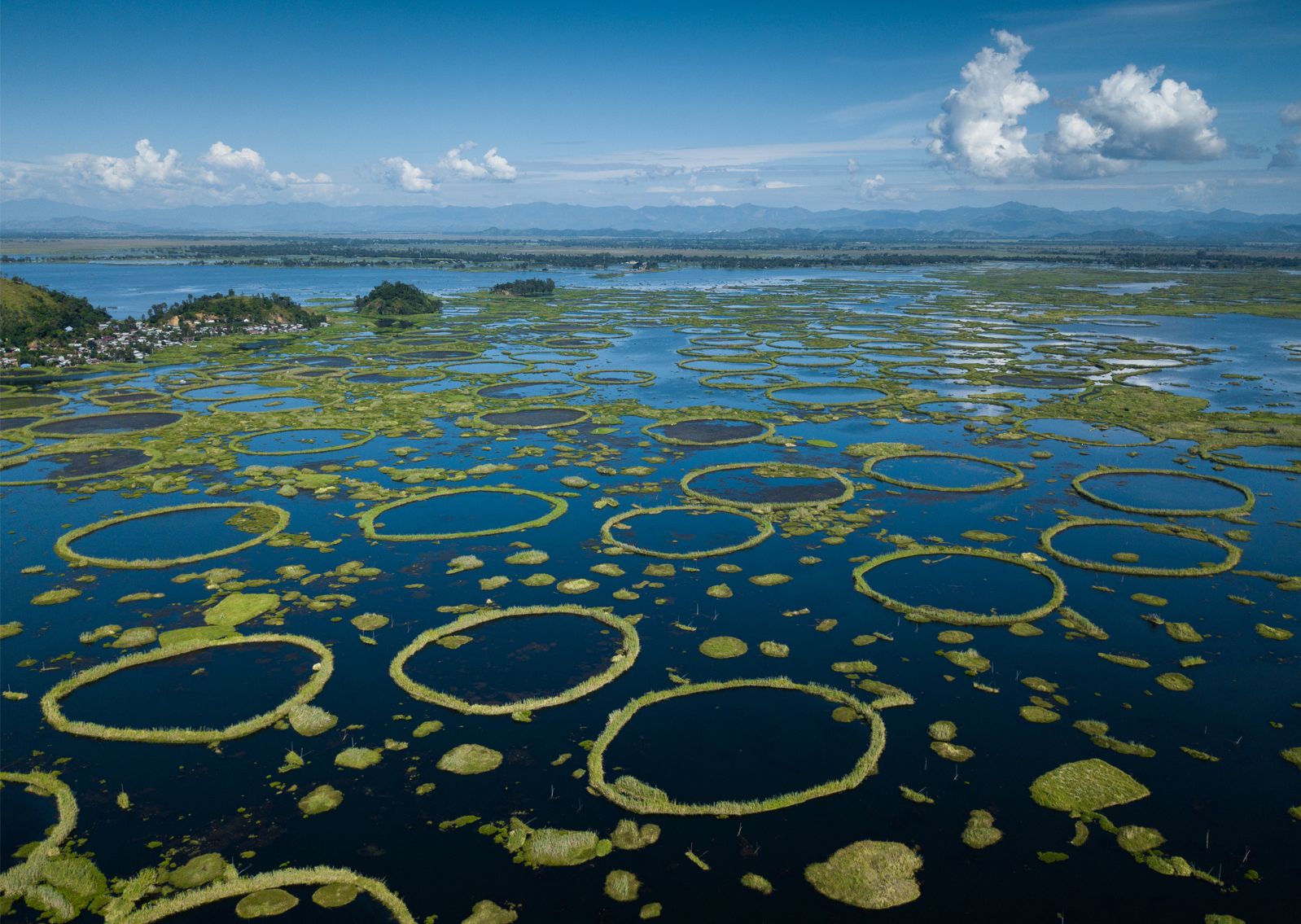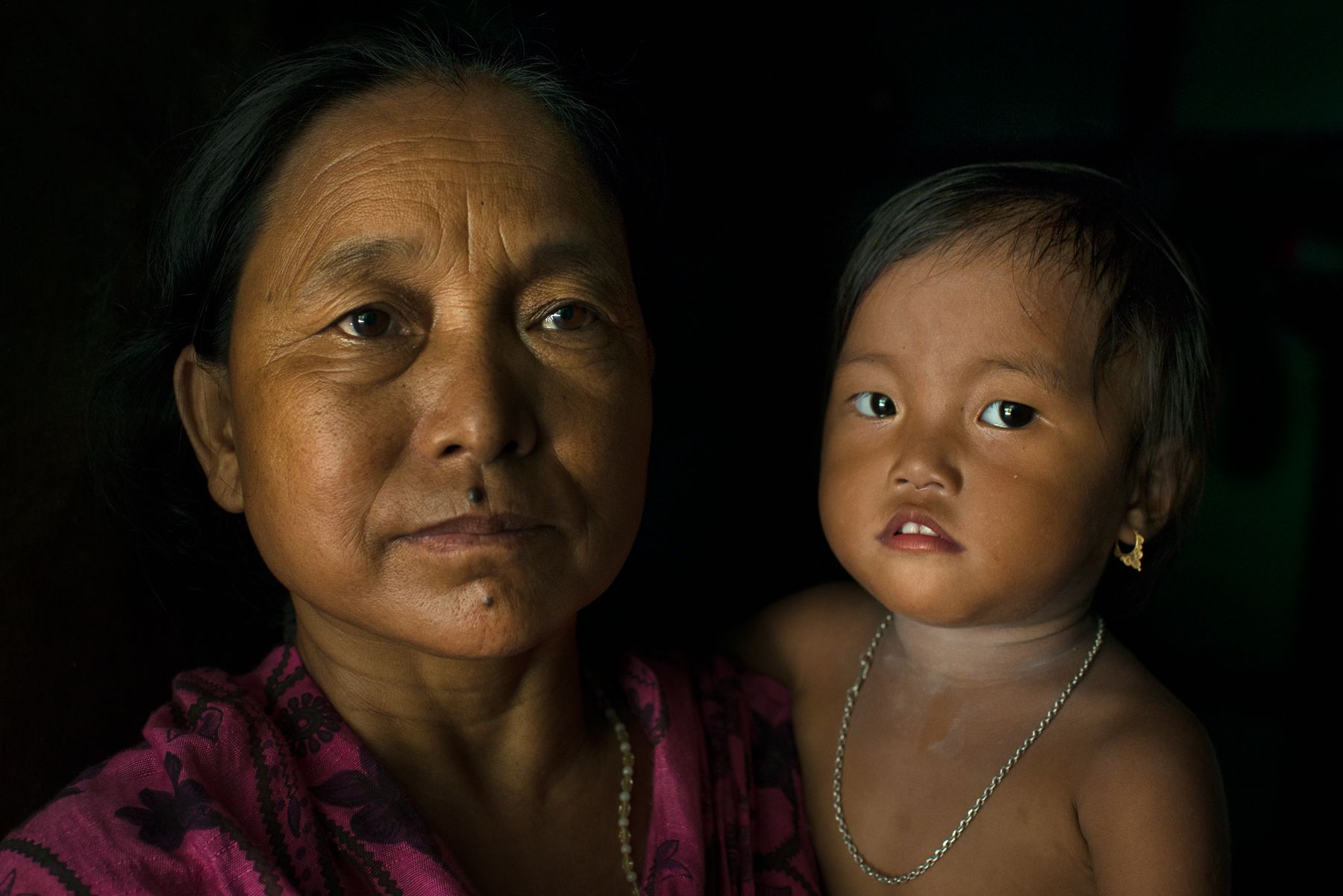Objective:
Students will evaluate how communities rely on their ecosystems for survival and climate change's impact on their ability to do so. They will examine text and photo stories about how the Meitei people of Manipur, India are affected by changes in the unique biome of Loktak Lake.
Introducing the Reporting:
Read the following introduction from “Loktak Wetland: Caught Between Development, Conflict, and Climate Change”:
Loktak Lake is a unique wetland and is listed as a Wetland of International Importance through the Ramsar Convention. The lake is distinctive due to the numerous green floating biomass (phumdis) that covers nearly two-thirds of the lake’s 236 square kilometers.
Phumdis or floating islands are comprised of vegetation, soil, and other organic matter. They change shape and size, moving around the lake surface depending on the season. The phumdis play a critical role in water cleansing, nutrient absorption, flood control, and carbon sequestration. Phumdis are home to some 425 species of animals, including the endangered “dancing deer,” over 100 species of birds, and over 200 species of aquatic plants.
Loktak Lake is home and means of livelihood to indigenous (Meiteis) families that live on Phumshangs. Some 30,000 fisher folks fish the lake. Over 100,000 people depend on the lake directly and indirectly for food and livelihood. The lake is of immense cultural, social and economic importance to some 55 communities that surround the lake. This photo essay documents how the Ithai hydroelectric dam, infrastructure projects, regional armed conflict and climate change threaten this unique ecosystem.
Quick check-in:
- What is an ecosystem? What is a biome?
- What are phumdis?
- Why are they important?
- What does it mean to be Indigenous?
- What does it mean to depend directly and indirectly on the lake for survival?
Warm-Up:
Consider your own ecosystem:
- What are your ecosystem's major features?
- Has your ecosystem changed over the last several years? How so?
- In what ways do people in your community depend directly and indirectly on your ecosystem for survival?
Activity:
1. Read the following introduction to "Manipur: Portraits of Resilience”:
The lives of over 100,000 people living in and around the Loktak Lake are economically, socially, and culturally linked to the lake. The lake supports a rich biodiversity of flora and fauna and is home to the Meitei tribes. This unique wetland is considered one of the most productive ecosystems in the world, making it a Wetland of International Importance. Development and regional conflict have endangered Loktak, threatening the livelihoods and identity of the Meiteis. Portraits of Resilience takes viewers up close to nine individuals to explore the relationship between the people and the lake as well as their fight for survival and self-identity. It gives a glimpse of how the lake intrinsically influences the existence of these individuals.
2. Divide into small groups and select one or more photo from “Manipur: Portraits of Resilience” (included below). At least one group should be studying each photo.

Kombirei Devi Khwairaakpam, 65. Thanga Tongbram Leikai, Manipur
Kombirei Devi Khwairaakpam, a retired fisherwoman who now spends part of her time weaving nylon-fishing nets. Change in water level and fish biodiversity in the lake after the construction of the Ithai Dam has forced fishermen to abandon traditional fishing technique and adopt the use of nylon fishing net. Women continue using traditional methods, thereby spending extended hours fishing compared to men. This not only impacts their health but also the time they spend tending their families.
Image by Neeta Satam. India, 2017.

Rocky Khwairaakpam, 36. Ithing, Manipur
Rocky Khwairaakpam has been fishing in Loktak Lake since he has been a teenager and he finds it increasingly challenging to survive off of fishing. Over the years after the 105 MW Ithai Dam was commissioned he has seen the fish population in the lake dwindle and native species such as Pengba, Sarang, Nara, and Khabag disappear.
Image by Neeta Satam. India, 2017.

Muktarei Oinam, 54. Thanga Tongbram Leikai, Manipur
For over two months Muktarei Oinam has been making numerous trips each day through her inundated yard to fetch water from the borewell. The flood destroyed her vegetable garden. Yards of numerous homes across the Loktak area remained flooded for weeks during monsoons not only destroying vegetable gardens and fishponds but also fruit-bearing trees. Experts believe that flooding in the region was an outcome of the Ithai Dam and climate change.
Image by Neeta Satam. India, 2017.

Indrajeet Tombram, 52. Thanga Khoirom Leikai, Manipur
Indrajeet Tombram takes a break from the backbreaking work of dredging out weeds that had proliferated on a fish farm where he works. Increased erosion and use of fertilizer along with an altered hydrology due to the commissioning of the Ithai Dam have resulted in increased rates of eutrophication of the lake.
Image by Neeta Satam. India, 2017.

Basant Salam, 32. Keibul Lamjao National Park, Manipur
Basant Salam has worked as a ranger in the Keibul Lamjao National Park for almost 10 years. A total of 35 unarmed forest guards are responsible for fighting sophisticatedly armed poachers who enter the floating national park to poach the endangered Sangai deer. In 2013, Salam fought two armed poachers, who were arrested, but managed to obtain a bail and now roam around scot-free.
Image by Neeta Satam. India, 2017.

Sonia Khwairaakpam, 24 and Malem Koirapam, four months. Thanga Tongbram Leikai, Manipur
Three weeks after Sonia Khwairaakpam gave birth to her son Malem, heavy rains flooded her home compelling her family to move out of their home. Hydrological changes from the construction of the Ithai Dam along with climate change have resulted in severe flooding that has never been seen before around the periphery of Loktak Lake.
Image by Neeta Satam. India, 2017.

Sanjit Shamon, 34. Champu Khangpok, Manipur
Sanjit Shamon is a fisherman and a resident of the village of Champu Khangpok. The village is comprised of numerous Phum Shangs (floating huts) in the Loktak Lake. Shamon fought back the police when they attempted to evict him during the November 2011 Phum Shang eviction drive. The Loktak Development Authority arsoned and dredged over 700 Phum Shangs in the name of lake clean-up after the introduction of Loktak Lake Protection Act 2006.
Image by Neeta Satam. India, 2017.

Salam Enao Meitei, 30. Thanga Tongbram Leikai, Manipur
Salam Enao Meitei, a poultry owner, poses for a portrait while preparing a meal for a luncheon. The younger generation in communities surrounding Loktak is moving away from the traditional livelihood of fishing because making a living from fishing has becoming challenging. The older generation has been encouraging the younger generation to get an education to find a different means of livelihood.
Image by Neeta Satam. India, 2017.

Moirang Themapabi, 60. Thanga Tongbram Leikai, Manipur
Moirang Themapabi has been fishing in Loktak Lake and selling her catch since she was a teenager. The construction of the Ithai Dam has resulted in fish scarcity in the lake, impacting the livelihood of her entire family. She spends more hours fishing than she did before the dam was constructed. Over the years due to long working hours, she has developed severe calf and backache issues.
Image by Neeta Satam. India, 2017.
3. After analyzing your photo(s) and caption(s), answer the following questions:
- What is this person’s role in their community?
- How does this person rely on Loktak Lake?
- How is this person’s life impacted by the changing ecosystem?
4. Share your group's responses with the class. What common themes can you see emerging from the discussion?
Extension Activities:
Option 1. The Meitei aren’t the only Indigenous people impacted by climate change. Identify another Indigenous group you would like to learn more about; consider turning toward your local community (your town/city, state, or country). Research and prepare a presentation that answers the following questions:
- What are the features of their ecosystem?
- How do they rely directly and indirectly on their environment for survival?
- How have they been impacted by climate change?
- What are people in this Indigenous community doing to combat climate change and/or its effects?
- Based on your research and that presented by your classmates, do you think that Indigenous groups are disproportionately affected by climate change? Why or why not?
These stories could serve as a starting place if you are looking to learn more about Indigenous groups dealing with climate change and environmental degradation:
- Indonesia: Palm Oil, Poverty, and Deforestation
- Brazil: The Guajajara Guardians Defending the Amazon Rainforest
- Norway: The Arctic's Sámi People Push for Sustainability
- Mexico: The Mazahua Battle for Water Rights
- Tanzania: The Maasai Battle Displacement and Drought
Option 2. In small groups or as a class, brainstorm ways that an individual, school, and community can help the environment. Divide a sheet of paper into thirds, label the sections “you,” “your school,” and “your community,” and work together to fill in each section. Create a large poster in the hallway at your school to encourage other students to add their own ideas.
Neeta Satam, the photojournalist whose reporting is featured in this lesson, is available to Skype with your class! Email [email protected] to schedule a conversation with her for your students.



